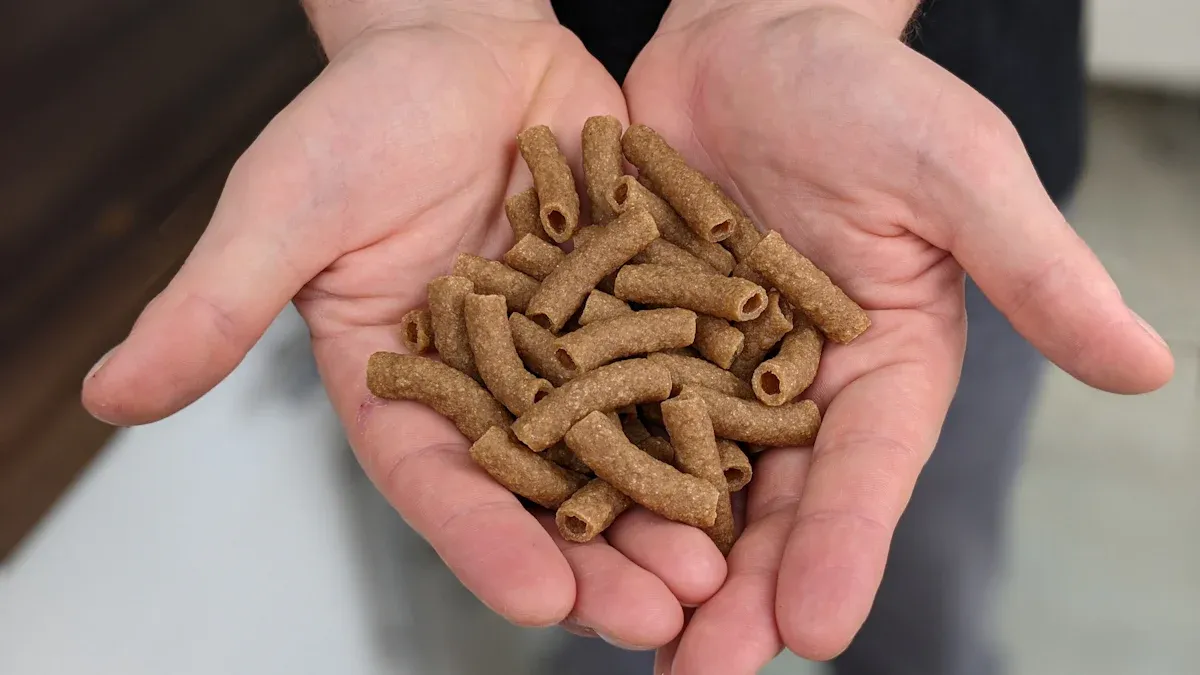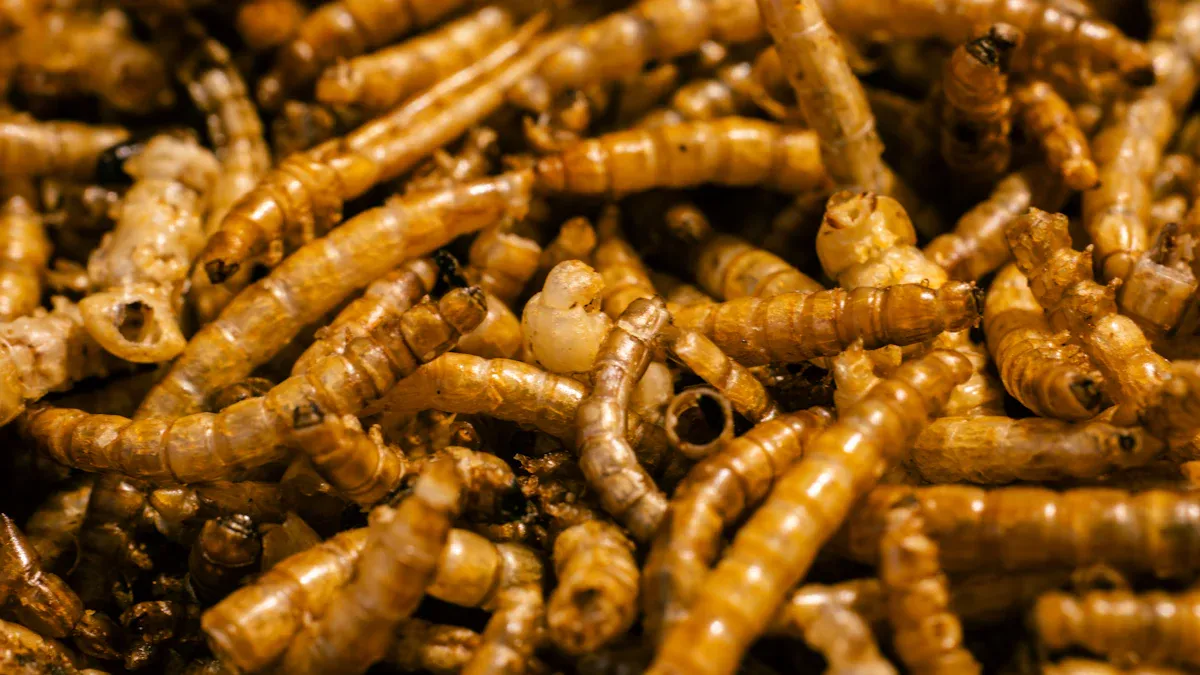
Modern agriculture faces a growing challenge: how to feed animals sustainably while conserving resources. Animal food products already account for 16% of global food needs but consume one-third of agricultural resources. Mealworms for animal feed offer a game-changing solution. With 79% protein and a water footprint far lower than beef, they’re both nutritious and eco-friendly. Asia’s leading mealworm supplier ensures consistent quality, making sustainable feeding practices more accessible than ever.
Key Takeaways
- Mealworms are rich in protein, about 68% to 76%. They help animals grow and stay healthy.
- Feeding animals mealworms is better for the environment. It uses less water and land than raising livestock. It also creates fewer greenhouse gases.
- Picking a trusted supplier gives safe and good-quality mealworms. This helps farmers feed their animals the best food.
Nutritional Benefits of Mealworms for Animal Feed

High Protein Content for Animal Growth
Protein is essential for animal growth, and mealworms deliver it in abundance. Studies show that mealworms can achieve protein levels as high as 68% to 76%, depending on their diet. This makes them an excellent choice for supporting muscle development and overall health in livestock, poultry, and fish. Unlike conventional feeds, mealworms provide a complete amino acid profile, ensuring animals get all the building blocks they need for growth.
Did you know? Mealworms for animal feed outperform traditional protein sources like chicken and beef in terms of protein density.
Essential Nutrients for Balanced Diets
Mealworms are more than just a protein powerhouse. They offer a wide range of essential nutrients that contribute to balanced animal diets. For instance, they are rich in vitamins like B12, riboflavin, and folate, as well as minerals such as magnesium and zinc. Here’s a quick comparison of their nutrient content:
| Nutrient | Amount (g/100 g edible portion) |
|---|---|
| Protein | 13.68–22.32 |
| Fat | 8.90–19.94 |
| Polyunsaturated fatty acids | Significant presence |
| Zinc | Present |
| Magnesium | High |
| Calcium | Low |
| Vitamin B12 | High |
This nutrient diversity makes mealworms a versatile and valuable addition to animal feed.
Advantages Over Conventional Feed Options
Mealworms for animal feed offer several advantages over traditional options like chicken and beef. They have a lower water footprint, reduced land use, and a smaller global warming potential. Here’s how they compare:
| Metric | Mealworms | Chicken Meat | Beef |
|---|---|---|---|
| Nutritional Value | Higher | Moderate | Lower |
| Water Footprint (m3/t) | 4341 | Comparable | 3.5 times higher |
| Global Warming Potential | Lower | Moderate | Higher |
| Land Use (kg/t) | Lower | Moderate | Higher |
These benefits make mealworms a sustainable and efficient alternative to conventional feeds. By choosing mealworms, farmers can reduce their environmental impact while providing high-quality nutrition for their animals.

Sustainability of Mealworm Production
Eco-Friendly Farming and Resource Efficiency
Mealworm farming stands out as a model of eco-friendly agriculture. It uses fewer resources compared to traditional livestock farming, making it a sustainable choice for animal feed production. Here’s why:
- Mealworm production generates significantly lower greenhouse gas emissions than raising cattle, pigs, or chickens.
- The land needed to produce 1 kg of mealworms is far less than that required for beef, chicken, or pork.
- With a water footprint of 4341 m³/t, mealworms match chicken and outperform beef by being 3.5 times more efficient.
- Their feed conversion efficiency rivals poultry, while their nitrogen use efficiency surpasses traditional livestock.
These metrics highlight how mealworm farming minimizes resource consumption while maximizing output, making it a smart choice for sustainable agriculture.
Contribution to Waste Reduction and Circular Economy
Mealworm farming doesn’t just conserve resources—it actively reduces waste. These insects thrive on organic waste, converting it into high-value products like protein-rich feed. This process requires less space, water, and energy than conventional livestock farming.
Additionally, mealworm farming supports the circular economy. By-products like insect frass (a nutrient-rich fertilizer) return essential nutrients to the soil, closing the loop in food production. This approach reduces waste and promotes sustainability, making mealworms for animal feed an eco-friendly solution.
Lower Environmental Impact Compared to Traditional Feed Sources
Mealworms have a much smaller environmental footprint than traditional feed sources. Here’s how they compare:
| Metric | Mealworms | Traditional Livestock |
|---|---|---|
| Energy used (per kg) | Similar to beef/pork | Higher than mealworms |
| Land area required (per kg) | Much less | More |
| Greenhouse gas emissions | Significantly lower | Higher |
| Feed conversion efficiency | Similar to poultry | Lower |
| Nitrogen use efficiency | Higher | Lower |
These advantages make mealworms a sustainable alternative to conventional feed options. Farmers can reduce their environmental impact while ensuring their animals receive high-quality nutrition.
Choosing Asia’s Leading Supplier for Mealworms
Commitment to Quality and Safety
When it comes to animal feed, quality and safety are non-negotiable. Asia’s leading supplier of mealworms ensures every batch meets strict quality standards. They use advanced processing techniques to maintain the nutritional value of mealworms while eliminating contaminants. Regular testing guarantees that the product is free from harmful substances, making it safe for all types of animals.
🛡️ Tip: Always check for certifications like ISO or HACCP when choosing a supplier to ensure their commitment to safety and quality.
This dedication to quality gives farmers peace of mind, knowing their animals are receiving the best possible nutrition.
Sustainable Sourcing Practices
Sustainability is at the heart of this supplier’s operations. They cultivate mealworms using eco-friendly methods that minimize resource use. Here’s how they achieve this:
- Mealworms thrive on organic waste, reducing the need for traditional feed inputs.
- Vertical farming systems allow for efficient use of space, making production scalable and sustainable.
- Compared to conventional protein sources, mealworm farming generates fewer greenhouse gas emissions and uses significantly less water.
These practices not only support the environment but also contribute to a circular economy by turning waste into valuable animal feed.
Proven Customer Satisfaction and Industry Expertise
Years of experience have made this supplier a trusted name in the industry. Farmers across Asia rely on their expertise to meet their feed requirements. Customer reviews highlight consistent product quality, timely delivery, and excellent support services.
🌟 Note: A supplier with a strong track record and positive feedback is a reliable choice for your feed needs.
Their commitment to innovation and sustainability ensures they remain a leader in providing mealworms for animal feed.
Practical Tips for Using Mealworms for Animal Feed
Selecting the Right Mealworms for Your Animals
Choosing the right mealworms depends on the nutritional needs of your animals. Mealworms vary in protein and fat content based on their diet and growth stage. For example, T. molitor larvae can contain 41% to 68% protein and 14% to 38% lipids. Animals like poultry and fish benefit from higher protein levels, while those requiring energy-rich diets may need mealworms with more fat.
To ensure optimal results, consider the feed substrate used during mealworm farming. Substrates like legumes and oil plants, which have protein levels between 22% and 42%, often produce mealworms with higher protein content. On the other hand, cereals with lower protein levels may result in mealworms better suited for animals with moderate protein requirements.
🐓 Tip: For poultry, mealworm meal can replace soybean meal in small amounts without affecting growth or health.
Proper Storage to Maintain Quality
Proper storage is crucial to preserving the nutritional value of mealworms for animal feed. Store dried mealworms in airtight containers to prevent moisture absorption, which can lead to mold growth. Keep them in a cool, dry place away from direct sunlight to maintain their protein and fat content.
For long-term storage, freezing is an excellent option. It helps retain freshness and prevents contamination. Always label containers with the storage date to ensure you use older batches first.
📦 Note: Avoid storing mealworms near strong-smelling substances, as they can absorb odors and affect feed quality.
Effective Ways to Incorporate Mealworms into Feed
Mealworms can be added to animal feed in various forms, such as whole dried worms, mealworm meal, or oil. Each form has unique benefits. For instance:
- Mealworm meal: Works well as a protein supplement in poultry and pig diets. Studies show no negative effects on growth when included in small amounts.
- Mealworm oil: Suitable for rabbits and aquaculture species like African catfish. It enhances fat content in fish and supports balanced nutrition.
- Whole dried mealworms: Ideal for birds and reptiles, providing a natural feeding experience.
In aquaculture, mealworm meal has shown promising results. Rainbow trout fed diets with 25% to 50% mealworm meal experienced improved growth performance. However, exceeding 50% inclusion may reduce feed efficiency in some species, like European sea bass.
🐟 Tip: Start with a 5% to 10% inclusion rate and monitor animal performance before increasing the amount.
Mealworms for animal feed offer unmatched nutritional and sustainability benefits. They provide essential amino acids, surpass beef and chicken in nutritional value, and use 3.5 times less water than beef. Asia’s leading supplier ensures top-quality mealworms, making sustainable feeding easy. Choosing mealworms supports eco-friendly practices while delivering premium nutrition for animals.
FAQ
What animals can eat mealworms?
Mealworms are suitable for poultry, fish, reptiles, and even some mammals. They provide essential nutrients for growth and health, making them a versatile feed option. 🐓🐟🦎
Are mealworms safe for all animals?
Yes, mealworms are safe when sourced from trusted suppliers. Always ensure proper storage and feeding amounts to maintain quality and avoid overfeeding.
🛡️ Tip: Consult a vet for specific animal needs.
How do mealworms compare to other protein sources?
Mealworms outperform traditional protein sources like soy and fishmeal. They offer higher protein density, better sustainability, and lower environmental impact, making them an eco-friendly choice. 🌱
Note: Mealworms also reduce reliance on overfished marine resources.


